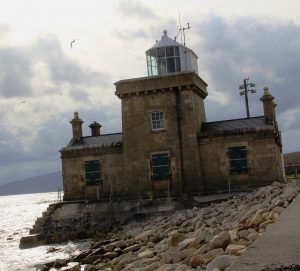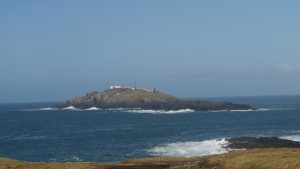Accommodation
Things To Do
Contact
For more information or to request a directory listing contact:+353 97 81500
info@visiterris.ie
Lighthouses of Erris
Blacksod Lighthouse
At the southern end of the Mullet Peninsula, Erris, County Mayo, at the entrance to Blacksod Bay. It is made of local granite blocks, which are believed to have come from Termon Hill, a nearby isolated outcrop of high quality granite. The keeper’s house is a two storey square building, which has always been unpainted. It is occupied by a resident lighthousekeeper who is also responsible for Blackrock Lighthouse. Blacksod is of unusual design for a lighthouse, being a square block of a building with only a small conical lantern section on top of it which is painted white. Although it is easily accessible as it is Blacksod Lighthouse was built in 1864 by one of the leading merchants in Belmullet at that time, Bryan Carey.
Weather observations in June 1944 by lighthousekeeper Ted Sweeney cause the Normandy landings to be postponed. While remaining neutral during World War II, Ireland continued to supply weather reports to Britain under an agreement in place since independence. D-Day had been scheduled to commence on 5 June 1944, but Sweeney’s report of approaching bad weather fronts caused Eisenhower to delay the invasion until 6 June 1944, when conditions were more favourable.
The house at Blacksod was badly damaged in 1989 by a rogue wave. It was repaired Blacksod Pier, it is not open to the general public.
Eagle Island Lighthouse
The Eagle Island lighthouses were a pair of lighthouses on Eagle Island, County Mayo, Ireland. of which only one remains.
Two lighthouses were commissioned in 1830 in response to requests from the Coastguards who were concerned at the sea conditions at Blackrock, further south. The Board inspector however, ruled in favour of locating the new lighthouses on Eagle Island, one in the east and the other in the west with 121 metres (132 yds) between them at a cost of almost £40,000 (roughly £3,200,000 or €4,160,000 in 2016). Their lights were aligned at a height of 67 m (220 ft) above sea level and could be seen to the east as far as Broadhaven Bay and to the south as far as Blacksod Bay. The lighthouses became operational in September 1835.
Eagle Island is located close to the edge of the Continental Shelf and is constantly pounded by powerful waves from the Atlantic. When the lighthouses were first built in the 19th century there were two lighthouses and seven dwelling houses on Eagle Island, according to the 1841 census. By the 1911 census there was only one dwelling house listed on the island. Despite the erection of a massive storm wall to protect the lighthouses, one of the lighthouses was destroyed by the severe storms and its remains still litter the ground it used to stand on.
Although the lighthouse sites sit almost 60 m (200 ft) above the high water mark, during a severe storm on 17 January 1836, a rock was thrown up the cliffs and smashed the glass in a window 27 m (87 ft) high up in the tower building. On 11 March 1861 at midday the light room of the East tower was struck by the sea, smashing 23 panes, washing some of the lamps down the stairs, and damaging the reflectors with broken glass beyond repair. The light was restored the following night with a reduced number of lamps and reflectors. So much water cascaded down the tower in the incident that it was impossible for the Keepers to open the door at the base, and they had to drill holes in it to let the water out.


